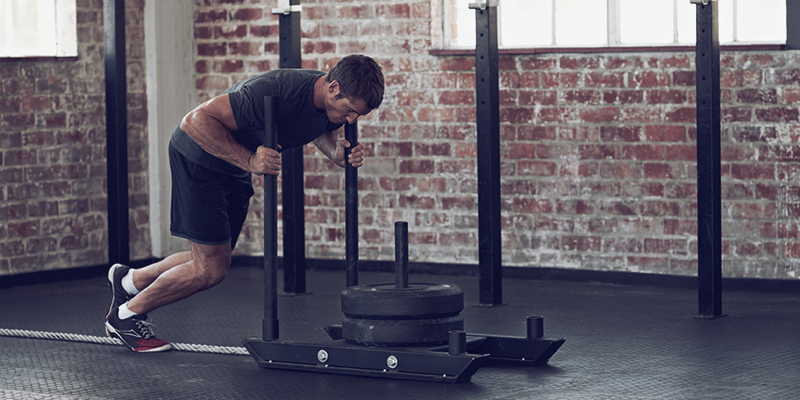Ditch the treadmill and enter the world of the metabolic finisher. It’s time to end your workouts like a boss and crank your metabolism into overdrive at the same time!
A metabolic finisher is an intense exercise or series of exercises performed at the end of your workout. Its purpose is to accelerate fat loss, increase your work capacity, and enhance your conditioning for better performance both in and out of gym.
Let’s take a look at five metabolic finishers you can add to your workout right now.
1. PROWLER OR SLED PUSHES AND PULLS
The sled has been around for a while, but it wasn’t until recently that it’s really become the gold standard in conditioning tools. The prowler forces you to sprint – but with a forward lean. This increases the activation of your body’s largest muscle: your glutes. In addition, pushing a sled has less eccentric stress than typical leg exercises, which means less muscle damage. In other words, you can go heavy and hard with the prowler and still be able to walk the next day.
As a finisher, simply push the prowler or sled as fast as possible for about 65 ft. When you hit the 65 ft. mark, pull it back by dragging it while walking backwards to the starting point. This is a five-minute drill – repeat it as many times a possible in that five minute span. Maintain good posture all the way through – especially on the return drag. Don’t sacrifice form for speed dragging the sled backwards. When you’re done, you’ll be sucking back so much air people around you will become oxygen deprived. Have fun!
2. BATTLE ROPES
Battle ropes are so intense they can make for a great workout all on their own. There are numerous moves you can perform with them: alternating waves, double waves, jumping jacks, plank single-arm waves, burpee alternating waves, seated crunch alternating waves – the list goes on and on.
Regardless of which one you choose, aim for 5 to 10 minutes of training with them after any workout as a finisher. Do 10 to 20 seconds all-out effort followed by a 30- to 45-second rest.
3. KETTLEBELL SWING/BURPEE – 10 SUPERSETS OF 10 COMBINATION
Even if you’re not a fan of kettlebells’ ability to build muscle, you have to respect their ability to crank up your heart rate and seriously challenge your endurance. Throw in some burpees (a.k.a. “the devil”) and you have a killer finishing combo that will crank up your metabolism and guzzle up any lingering pre-workout energy you still have kicking around your system. Perform 10 swings, superset with 10 burpees. Rest for 20 seconds and repeat until you’ve completed 10 supersets. Choose a kettlebell weight that provides a challenge – 50 to 70 lbs. is a great starting weight for men, and 25 to 40 lbs. is a great starting weight for women. Adjust the weight as needed.
4. THE BARBELL COMPLEX
If you’re feeling that sleds, battle ropes and kettlebells are a little too cross fitness for you, and you have a hunger for more barbell work, try this barbell complex finisher. It consists of the deadlift, bent-over row, hang clean, push press and back squat. Use the same weight for all six exercises and perform them without rest. Do 10 reps of each exercise. Repeat this complex twice, resting no longer than a minute and a half between complexes.
5. LOADED CARRIES
Loaded carries might be simple, but don’t be deceived – done correctly they can add size to your traps and delts, giving you crushing grip strength. The most common loaded carry is the farmer’s walk, which simply requires you to pick up two heavy dumbbells or barbells and walk.
There are other challenging, one-handed variations, however, that really help develop overall strength and balance. These include the waiter’s walk, where the weight is held with a straight arm overhead; the suitcase walk, essentially a one-handed farmer’s walk; and the rack walk, where you clean a dumbbell to a racked position.
Use a weight that is challenging. If you’ve been training for any length of time, start at 60 lbs.– especially for the farmers and suitcase walks (go lighter for the waiters walk).
Add these at the end of three workouts each week. Simply pick up the weight and move quickly, walking as fast as you can for 30 seconds. Rest for 1 minute and repeat for 5 sets. If it’s too easy, add more weight or increase the duration of your walk.








